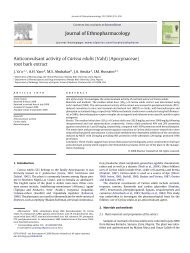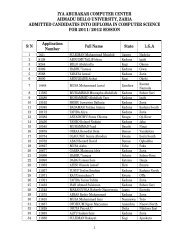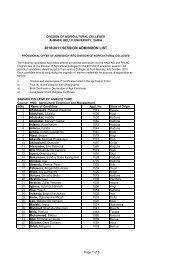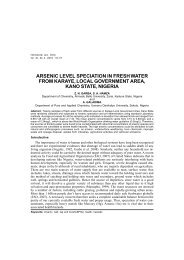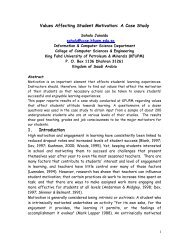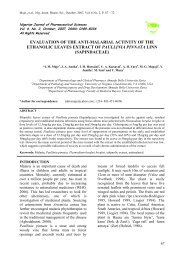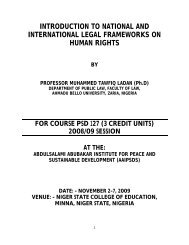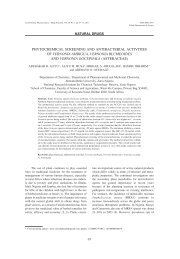Cell-mediated immunity in Type 2 diabetes mellitus patients in ...
Cell-mediated immunity in Type 2 diabetes mellitus patients in ...
Cell-mediated immunity in Type 2 diabetes mellitus patients in ...
You also want an ePaper? Increase the reach of your titles
YUMPU automatically turns print PDFs into web optimized ePapers that Google loves.
Journal of Medic<strong>in</strong>e and Medical Sciences Vol. 1(7) pp. 290-295 August 2010<br />
Available onl<strong>in</strong>e http://www.<strong>in</strong>teresjournals.org/JMMS<br />
Copyright ©2010 International Research Journals<br />
Full Length Research paper<br />
<strong>Cell</strong>-<strong>mediated</strong> <strong>immunity</strong> <strong>in</strong> <strong>Type</strong> 2 <strong>diabetes</strong> <strong>mellitus</strong><br />
<strong>patients</strong> <strong>in</strong> diabetic ketoacidosis, <strong>patients</strong> with<br />
controlled <strong>Type</strong> 2 <strong>diabetes</strong> <strong>mellitus</strong> and healthy control<br />
subjects.<br />
Musa, B. O. P. 1 , Onyemelukwe, G.C. 1 , Hambolu, J. O. 2 , Bakari, A.G. 3 , Anumah, F.E. 3<br />
1 Immunology Unit, Department of Medic<strong>in</strong>e, A.B.U.T.H. Zaria,<br />
2 Department of Veter<strong>in</strong>ary Anatomy, Faculty of Veter<strong>in</strong>ary Medic<strong>in</strong>e, Ahmadu Bello University, Zaria and 3 Endocr<strong>in</strong>ology<br />
Unit, Department of Medic<strong>in</strong>e, A.B.U.T.H. Zaria, Nigeria<br />
Accepted 19 July, 2010<br />
Immune modulation accompany<strong>in</strong>g metabolic dysfunction can adversely affect outcome of a non<br />
<strong>in</strong>fectious disease such as type 2 <strong>diabetes</strong> <strong>mellitus</strong> (T2DM). Peripheral T lymphocyte subsets were<br />
analyzed with monoclonal antibodies via manual count<strong>in</strong>g by the <strong>in</strong>direct immunofluorescence method,<br />
<strong>in</strong> type 2 Diabetes <strong>mellitus</strong> <strong>patients</strong> <strong>in</strong> DKA, controlled T2DM <strong>patients</strong> as well as normal healthy controls<br />
(NHC).There was a significant decrease <strong>in</strong> CD4+ T cells alongside a non significant <strong>in</strong>crease <strong>in</strong> CD8+ T<br />
cells <strong>in</strong> <strong>patients</strong> with diabetic ketoacidosis (DKA) compared to controlled T2DM <strong>patients</strong> and normal<br />
healthy controls. Ratio of CD4/CD8+ T cells was also lowest <strong>in</strong> DKA. These T cell changes <strong>in</strong> <strong>patients</strong><br />
with DKA reflect an abnormal immunoregulatory mechanism <strong>in</strong> parallel with an impaired metabolic<br />
process and may lead to enhanced beta cell damage and <strong>in</strong>creased susceptibility to DKA crisis <strong>in</strong> T2DM<br />
<strong>patients</strong>.<br />
Keywords: <strong>Cell</strong> <strong>mediated</strong> <strong>immunity</strong>, diabetic ketoacidosis, <strong>Type</strong> 2 <strong>diabetes</strong> <strong>mellitus</strong>, metabolic dysfunction, T<br />
lymphocytes<br />
INTRODUCTION<br />
Diabetic ketoacidosis (DKA) is an extremely serious<br />
metabolic consequence of <strong>diabetes</strong> <strong>mellitus</strong> (DM) due to<br />
a state of relative or absolute <strong>in</strong>sul<strong>in</strong> deficiency and a<br />
relative or absolute <strong>in</strong>crease <strong>in</strong> counter regulatory<br />
hormones (Hamburger and Rush, 1993). A triad of<br />
acidosis, ketosis and hyperglycaemia are often<br />
characteristic of this condition, with DKA also be<strong>in</strong>g<br />
associated with poor control of DM, precipitat<strong>in</strong>g<br />
<strong>in</strong>fections or diseases and first presentation with<br />
<strong>diabetes</strong>. Despite recent advances <strong>in</strong> therapy, mortality<br />
and morbidity <strong>in</strong> DKA rema<strong>in</strong> alarm<strong>in</strong>gly high especially <strong>in</strong><br />
develop<strong>in</strong>g countries like Nigeria.<br />
Previous studies had found impaired white cell function,<br />
defective mobilization of polymorphonuclear leucocytes<br />
and alteration of leucocyte sialic acid and sialidase<br />
activity <strong>in</strong> <strong>patients</strong> with DKA (Chari and Nath, 1984).<br />
More recent studies have demonstrated abnormal cellular<br />
*Correspond<strong>in</strong>g author e-mail: bolamusa2002@yahoo.com<br />
and humoral <strong>immunity</strong> <strong>in</strong> <strong>patients</strong> with DKA (Habib et al,<br />
1998), while research over the last decade has<br />
suggested an association between lymphocyte<br />
membrane receptor <strong>in</strong> vitro glycosylation and altered<br />
lymphocyte function lead<strong>in</strong>g to lowered<br />
immunocompetence <strong>in</strong> <strong>patients</strong> with DKA (Ifere,2000).<br />
These results suggest a discordant immune profile <strong>in</strong><br />
these <strong>patients</strong>.<br />
Although, DKA is generally considered a consequence<br />
of type 1 DM with <strong>in</strong>sul<strong>in</strong> deficiency associated with beta<br />
cell damage, studies have shown that DKA is associated<br />
with type 2DM as well (Carroll and Schade, 2000). There<br />
is a high <strong>in</strong>cidence of type 2 DM <strong>in</strong> Zaria, Nigeria and<br />
DKA is associated with type 2 DM <strong>in</strong> this environment.<br />
Reasons postulated for the prevalence of DKA <strong>in</strong> type2<br />
DM <strong>in</strong> Zaria <strong>in</strong>clude hyperglycaemia (<strong>in</strong>dicat<strong>in</strong>g poor<br />
metabolic control) as well as the stimulus of endemic<br />
<strong>in</strong>fections or underly<strong>in</strong>g disease.<br />
S<strong>in</strong>ce ambient glucose concentrations can profoundly<br />
affect lymphocyte response and consequently the
Musa et al. 291<br />
immune response to <strong>in</strong>fections and disease, this may be<br />
responsible for the development of conditions favour<strong>in</strong>g<br />
the presence of DKA <strong>in</strong> type 2 DM <strong>patients</strong>. This study<br />
therefore exam<strong>in</strong>ed numerical peripheral T- lymphocyte<br />
populations <strong>in</strong> <strong>patients</strong> with type 2 DM with DKA <strong>in</strong> Zaria<br />
at presentation and compared with that of matched type 2<br />
DM <strong>patients</strong> <strong>in</strong> good metabolic control as well as matched<br />
normal healthy control subjects.<br />
PATIENTS AND METHODS<br />
Patients<br />
The study <strong>in</strong>volved <strong>patients</strong> from the medical wards (for <strong>patients</strong> <strong>in</strong><br />
diabetic ketoacidosis) and the Endocr<strong>in</strong>ology Cl<strong>in</strong>ic (for controlled<br />
diabetic <strong>patients</strong>) of the Ahmadu Bello University Teach<strong>in</strong>g<br />
Hospital, Zaria, Nigeria.<br />
A total of twenty-one (21) <strong>patients</strong> admitted to the Medical wards<br />
<strong>in</strong> diabetic ketoacidosis (DKA) with an ‘unacceptable’ glycaemic<br />
<strong>in</strong>dex reflected by a blood glucose level >13mmol/L, serum<br />
bicarbonate
292 J. Med. Med. Sci.<br />
Table 1. Cl<strong>in</strong>ical characteristics of <strong>patients</strong> with DKA, controlled T2DM <strong>patients</strong> and normal healthy controls (NHC)<br />
Characteristics of<br />
the Patients<br />
Group 1<br />
DKA <strong>patients</strong><br />
N = 22<br />
Group 2<br />
T2DM <strong>patients</strong><br />
n =22<br />
Group3<br />
Normal healthy<br />
controls n = 20<br />
Age 46 ± 4 48±15 43 ± 6 NS<br />
Gender M:F 2.8: 1 M:F 2.8:1 M:F 2.9:1 NS<br />
BMI (kg/m 2 ) 23 ± 4 25 ± 5 27 ± 6 NS<br />
Glucose mmol/L<br />
Fast<strong>in</strong>gblood glucose<br />
2 hr postprandial<br />
25 ± 2<br />
17 ± 4<br />
26 ± 9<br />
5 ± 0.4<br />
5 ± 0.4<br />
8 ± 0.7<br />
4 ± 1<br />
4 ± 0.6<br />
6 ± 0.6<br />
p – value<br />
Musa et al. 293<br />
Table 3. Haematological <strong>in</strong>dices <strong>in</strong> <strong>patients</strong> <strong>in</strong> DKA, controlled T2DM and normal healthy controls (mean + SD)<br />
Parameters<br />
DKA <strong>patients</strong><br />
n=22<br />
T2DM <strong>patients</strong><br />
n=22<br />
Normal healthy<br />
controls<br />
n=20<br />
p- value<br />
PCV % 35 ± 1 37 ± 4 40 ± 5 p
294 J. Med. Med. Sci.<br />
DISCUSSION<br />
The study demonstrates abnormalities <strong>in</strong> cell <strong>mediated</strong><br />
<strong>immunity</strong> <strong>in</strong> the peripheral T lymphocyte subset <strong>in</strong><br />
<strong>patients</strong> with DKA when compared with healthy subjects<br />
and controlled type 2 <strong>diabetes</strong> <strong>mellitus</strong> (T2DM) <strong>patients</strong>.<br />
All the <strong>patients</strong> <strong>in</strong> DKA <strong>in</strong> this study were T2DM <strong>patients</strong>.<br />
A significant difference was also detected <strong>in</strong> numerical<br />
peripheral blood T lymphocytes between healthy subjects<br />
and those with controlled T2DM. The evidence of an<br />
imbalance <strong>in</strong> cell <strong>mediated</strong> <strong>immunity</strong> found <strong>in</strong> <strong>patients</strong><br />
with DKA <strong>in</strong> this study suggests a possible relationship<br />
between glucose control, abnormal cellular <strong>immunity</strong> and<br />
the development of DKA. This implies that ambient<br />
glucose concentrations <strong>in</strong> a non <strong>in</strong>fectious disease like<br />
<strong>diabetes</strong> <strong>mellitus</strong> can act as a stressor affect<strong>in</strong>g immune<br />
modulation and outcome of disease.<br />
The f<strong>in</strong>d<strong>in</strong>gs <strong>in</strong> the early seventies of Brodie and Merlie<br />
(1970), Ragab et al. (1972) and MacCuish et al. (1974)<br />
highlight this fact, <strong>in</strong>dict<strong>in</strong>g the heterogeneity of DM as a<br />
reason for differences <strong>in</strong> T cell populations and function.<br />
Brody and Merlie (1970), reported marked depression of<br />
the transformation response to phytohaemagglut<strong>in</strong><strong>in</strong><br />
(PHA) by lymphocytes from six elderly diabetic <strong>patients</strong><br />
when compared to normal subjects. Ragab et al. (1972)<br />
on the other hand, found no difference <strong>in</strong> the PHA<br />
response of a larger number (23) of diabetics and<br />
controls. Interest<strong>in</strong>gly, the disparity between their results<br />
was paralleled by the metabolic state of the diabetics at<br />
the time of the study. Patients studied by Brodie and<br />
Merlie (1970) were poorly controlled and hyperglycaemic<br />
while those of Ragab et al. (1972) were well controlled<br />
and normoglycaemic. Similarly MacCuish et al. (1974)<br />
compar<strong>in</strong>g PHA responses <strong>in</strong> well and poorly controlled<br />
diabetics found depressed responses only <strong>in</strong> the latter<br />
group. Diabetics with DKA <strong>in</strong> this study were<br />
hyperglycaemic compared to stable diabetics and normal<br />
healthy controls suggest<strong>in</strong>g that the significant<br />
differences <strong>in</strong> their lymphocyte subsets could be a<br />
reflection of metabolic disturbance. Hyperglycaemia is<br />
exaggerated <strong>in</strong> DKA by <strong>in</strong>creased levels of circulat<strong>in</strong>g<br />
catecholam<strong>in</strong>es, glucagon and cortisol. These have<br />
profound effects on lymphocytes which may reflect <strong>in</strong> the<br />
reduced T cell levels <strong>in</strong> <strong>patients</strong> with DKA <strong>in</strong> this study as<br />
opposed to T2DM and NHC and <strong>in</strong>dicate a l<strong>in</strong>k between<br />
the immune and endocr<strong>in</strong>e systems.<br />
White blood cells <strong>in</strong>clud<strong>in</strong>g lymphocytes and their<br />
functions are also globally affected by ambient glucose<br />
concentrations (Alberti, 1977) and this is regarded as the<br />
likeliest explanation for the <strong>in</strong>creased suspicion of <strong>in</strong>fection<br />
<strong>in</strong> <strong>patients</strong> with DKA. Infections play a role as disease<br />
precipitat<strong>in</strong>g factors and many of them are known to be<br />
associated with a reduced CD4/CD8 ratio. It was not<br />
possible to identify via microscopy and culture <strong>in</strong>fectious<br />
causes <strong>in</strong> DKA <strong>patients</strong> <strong>in</strong> the study. Infection was<br />
suspected based ma<strong>in</strong>ly on cl<strong>in</strong>ical signs <strong>in</strong> 73% of our<br />
<strong>patients</strong> with diabetic ketoacidosis as they were adm-<br />
itted <strong>in</strong>to the study on the premise of ‘no overt <strong>in</strong>fection’.<br />
These cl<strong>in</strong>ical signs <strong>in</strong>cluded fever, diarrhoea and cough.<br />
Infections are known to decrease levels of corticosteroid<br />
b<strong>in</strong>d<strong>in</strong>g globul<strong>in</strong> lead<strong>in</strong>g to <strong>in</strong>creased levels of circulat<strong>in</strong>g<br />
free corticosteroids (Cooper and Stewart, 2003).<br />
Corticosteroids released dur<strong>in</strong>g stress are<br />
immunosuppressive <strong>in</strong> vivo (Chambers and Schauenste<strong>in</strong>,<br />
2000). In acutely ill <strong>patients</strong> this results <strong>in</strong> an <strong>in</strong>crease <strong>in</strong><br />
cortisol production that is roughly proportional to the<br />
severity of the illness (Cooper and Stewart, 2003). This<br />
stress <strong>in</strong>duced endogenous release of glucocorticoids<br />
possibly due to an anti-<strong>in</strong>fectious response is a potential<br />
mechanism of lymphocyte apoptosis (Hotchkiss and Karl,<br />
2003) that may be responsible for the reduced numbers<br />
of CD3+ and CD4+ T cells <strong>in</strong> <strong>patients</strong> with DKA and<br />
steady state T2 DM <strong>patients</strong> <strong>in</strong> this study. Fever is closely<br />
associated with malaria <strong>in</strong> this environment and malaria<br />
is associated with reduced CD4+ and CD8+ T cell<br />
numbers.<br />
The reversibility of DKA with the adm<strong>in</strong>istration of<br />
<strong>in</strong>sul<strong>in</strong> is also a very <strong>in</strong>terest<strong>in</strong>g phenomenon buttress<strong>in</strong>g<br />
the case <strong>in</strong> po<strong>in</strong>t of metabolic dysfunction and lowered<br />
immunocompetence <strong>in</strong> T2DM. Although 50% of the<br />
<strong>patients</strong> with DKA eventually died due to the severity of<br />
their conditions, the other half survived on standard care<br />
<strong>in</strong>volv<strong>in</strong>g <strong>in</strong>sul<strong>in</strong> therapy. Kitabchi et al., (2004) study<strong>in</strong>g<br />
the <strong>in</strong> vivo activation of CD4 and CD8 lymphocytes <strong>in</strong><br />
<strong>patients</strong> with DKA on admission and at resolution by<br />
measur<strong>in</strong>g de novo growth factor receptors found<br />
<strong>in</strong>creased levels of growth factor receptors <strong>in</strong> association<br />
with markers of oxidative stress <strong>in</strong> <strong>patients</strong> with DKA.<br />
Consequently, <strong>in</strong> the likelihood that DKA causes<br />
immunosuppression, Kitabchi et al., (2004) proposed that<br />
DKA changes T lymphocytes to <strong>in</strong>sul<strong>in</strong> sensitive tissues<br />
as a compensatory mechanism. Insul<strong>in</strong> prevents<br />
apoptotic cell death from various stimuli by activat<strong>in</strong>g the<br />
phosphatidyl<strong>in</strong>ositol 3- k<strong>in</strong>ase-Akt pathway (Hotchkiss<br />
and Karl, 2003) and prevention of lymphocyte apoptosis.<br />
Insul<strong>in</strong> also reduces plasma glucose concentrations <strong>in</strong><br />
DKA and lowers mortality rates (English and Williams,<br />
2004). Insul<strong>in</strong> as a secreted hormone prevent<strong>in</strong>g<br />
apoptosis is similar to cytok<strong>in</strong>es produc<strong>in</strong>g signals<br />
<strong>in</strong>hibitory to apoptosis. Such cytok<strong>in</strong>es are said to be<br />
crucial for cell survival <strong>in</strong>dicat<strong>in</strong>g vital parallels between<br />
endocr<strong>in</strong>e and cytok<strong>in</strong>e signall<strong>in</strong>g necessary for<br />
ma<strong>in</strong>ta<strong>in</strong><strong>in</strong>g the balance between life and death.<br />
Consequently this protective mechanism of <strong>in</strong>sul<strong>in</strong> <strong>in</strong><br />
DKA may <strong>in</strong>dicate the term<strong>in</strong>ation of apoptotic<br />
mechanisms due to <strong>in</strong>flammation, hyperglycaemia as well<br />
as hypo<strong>in</strong>sul<strong>in</strong>aemia. Bakari and Onyemelukwe (2004) <strong>in</strong><br />
their study of plasma <strong>in</strong>sul<strong>in</strong> response to oral glucose<br />
challenge <strong>in</strong> <strong>patients</strong> with type 2 DM (T2DM) <strong>in</strong> Zaria,<br />
found low <strong>in</strong>sul<strong>in</strong> outputs and proposed that the<br />
underly<strong>in</strong>g defect <strong>in</strong> African type 2 <strong>diabetes</strong> could be beta<br />
cell malfunction with consequent low <strong>in</strong>sul<strong>in</strong> outputs <strong>in</strong><br />
the population. T cells rather than autoantibodies are<br />
said to be responsible for this defect which could alter the
Musa et al. 295<br />
<strong>in</strong>sul<strong>in</strong>-glucagon ratio to the extent that DKA is<br />
precipitated <strong>in</strong> a type 2 <strong>diabetes</strong> <strong>mellitus</strong> patient (Yu et al.<br />
2006).<br />
The slightly elevated CD8+ T cells <strong>in</strong> <strong>patients</strong> <strong>in</strong> DKA <strong>in</strong><br />
this study <strong>in</strong> conjunction with significantly low levels of<br />
CD4+ T cells would <strong>in</strong>dicate acute critical illness with<br />
consequently an overload of the immune response. In<br />
such a situation, there is stimulation of suppressor CD8+<br />
T cells and limitation of antigen <strong>in</strong>duced lymphocyte<br />
proliferative responses by the production of suppressor<br />
factors. Additionally, the elevation of CD8+ T cells<br />
observed <strong>in</strong> this study may be as a result of sequestration<br />
of CD4+ T cells to the pancreas <strong>in</strong> T2DM <strong>in</strong>volv<strong>in</strong>g antiislet<br />
T cell <strong>mediated</strong> pathogenic mechanisms (Yu et al.<br />
2006). The similar presence of higher numbers of<br />
suppressor (CD8+) T cells <strong>in</strong> normal human controls as<br />
compared to stable diabetic <strong>patients</strong> (T2DM) could imply<br />
the presence of non overt sub cl<strong>in</strong>ical <strong>in</strong>fections such as<br />
preimmune malaria <strong>in</strong> these <strong>patients</strong>.<br />
In conclusion, the study shows that impaired cell<br />
<strong>mediated</strong> <strong>immunity</strong> is prevalent <strong>in</strong> T2DM <strong>patients</strong> with<br />
DKA. Aberrant glucose concentrations, hypo<strong>in</strong>sul<strong>in</strong>aemia,<br />
<strong>in</strong>fections or underly<strong>in</strong>g disease can exert enough stress<br />
to affect the immune cell population and <strong>in</strong>fluence<br />
adversely the outcome of T2DM <strong>in</strong> Nigerians. This may<br />
be reflected <strong>in</strong> a lowered immunocompetence (a<br />
deranged immune cell milieu and function) and metabolic<br />
dysfunction as is seen <strong>in</strong> DKA.<br />
As this was a case control study with the attendant<br />
limitations of the study group be<strong>in</strong>g def<strong>in</strong>ed by outcome, it<br />
becomes difficult to categorically establish a causal<br />
status of hyperglycaemia and deficient T lymphocytes.<br />
Further studies on these abnormalities of the cell<br />
<strong>mediated</strong> immune response <strong>in</strong> DKA and the role of <strong>in</strong>sul<strong>in</strong><br />
<strong>in</strong> correct<strong>in</strong>g this anomaly are required.<br />
ACKNOWLEDGEMENT<br />
Chari SN, Nath N (1984). Sialic acid content and sialidase activity of<br />
polymorphonuclear leucocytes <strong>in</strong> <strong>diabetes</strong> <strong>mellitus</strong>. Ame. J. Med. Sci.;<br />
288(1):18-20.<br />
Cooper MS, Stewart PM (2003). Corticosteroid <strong>in</strong>sufficiency <strong>in</strong> acutely ill<br />
<strong>patients</strong>. N. Eng. J. Med. 348:727-731<br />
Dacie JV, Lewis SM (1991). Practical Haematology, 7 th Ed, Ed<strong>in</strong>burgh:<br />
Churchill Liv<strong>in</strong>gstone. Pp. 54-79.<br />
English P, Williams G (2004). Hyperglycaemic crises and lactic<br />
acidosis <strong>in</strong> <strong>diabetes</strong> <strong>mellitus</strong>. Post Grad. Med. J. 80:253-261<br />
Faustman D, Eisenbarth G, Daley J, Brentmeyer J (1989). Abnormal T-<br />
lymphocyte subsets <strong>in</strong> type 1 <strong>diabetes</strong>. Diabetes 38:1462.<br />
Gupta S, Good RA (1989). Subpopulations of human lymphocytes.1.<br />
Studies <strong>in</strong> immunodeficient <strong>patients</strong>. Cl<strong>in</strong>. Exp. Immunol. 30:222<br />
Habib, A.G., Gebi, U.I., Sani, B.G., Maisaka, M.U., Oyeniyi, T., Musa,<br />
B.O., Onyemelukwe, G.C. (1998). Insul<strong>in</strong> dependent <strong>diabetes</strong><br />
<strong>mellitus</strong> complicat<strong>in</strong>g follicular lymphoma <strong>in</strong> an adult Nigerian:<br />
immunobiological aspects. Intern. Diab. Dig. 7(2):334<br />
Hamburger S, Rush D (1993). Diabetic emergencies. In Kraus, Werner<br />
and Jacobs (Eds) ‘Emergency medic<strong>in</strong>e’ 3 rd<br />
Edn.. Raven Press,<br />
N.Y.pp.233-248.<br />
Hotchkiss, R.S. and Karl, I.E. (2003). The pathophysiology and<br />
treatment of sepsis. The New Eng. J. Med. 348:2.<br />
Ifere OG (2000). Lymphocytes membrane prote<strong>in</strong> glycosylation: a possible<br />
cause of lowered immunocompetence <strong>in</strong> diabetic subjects. Diabete<br />
Intern.; 10(1):14-15.<br />
Khan SA, Khan LA. (2000) Presentation and outcome of diabetic<br />
ketoacidosis <strong>in</strong> Najran, Saudi Arabia. Diab. Int. 10 (2):50-51.<br />
Kitabchi AE, Wall BM (1995). Diabetic ketoacidosis. Med. Cl<strong>in</strong>. North<br />
Am. 79:9-37<br />
MacCuish AC, Urbanick SJ, Campbell CJ, Duncan LJP, Irv<strong>in</strong>e WJ<br />
(1974). Phytohaemagglut<strong>in</strong><strong>in</strong> transformation and circulat<strong>in</strong>g<br />
lymphocyte subpopulations <strong>in</strong> <strong>in</strong>sul<strong>in</strong> dependent diabetics. Diabetes<br />
23: 222.<br />
Musa BOP, Geoffrey C, Onyemelukwe JO, Hambolu A, Mamman I,<br />
Isa HA (2010). Pattern of Serum cytok<strong>in</strong>e expression and T cell<br />
subsets <strong>in</strong> Sickle <strong>Cell</strong> Disease Patients <strong>in</strong> vaso-occlusive crisis. Cl<strong>in</strong><br />
and Vacc. Immunol. 17(4): 602-608.<br />
Ragab. AH, Hazlett B, Cowen DH (1972). Response of peripheral<br />
blood lymphocytes from <strong>patients</strong> with <strong>diabetes</strong> <strong>mellitus</strong> to<br />
phytohaemagglut<strong>in</strong><strong>in</strong> and Candida albicans antigen. Diab. 21:906.<br />
Tietz NW (2001). Cl<strong>in</strong>ical chemistry <strong>in</strong> laboratory tests. WB Sanders,<br />
London.<br />
Yu L, Wang J, Eisenbarth GS (2006). In `Endocr<strong>in</strong>opathies`. In<br />
Detrick,B, Hamilton, R.G. and Folds, J.D.Eds Manual of Molecular<br />
and cl<strong>in</strong>ical Laboratory Immunology 7th edition. ASM press, USA<br />
pp.1069.<br />
The authors wish to acknowledge the excellent technical<br />
assistance of Dr T.S.Kene <strong>in</strong> the statistical analysis of<br />
data.<br />
REFERENCES<br />
Alberti KGMM, Hockaday TDR (1977) Diabetic coma- a reappraisal<br />
after five years. Cl<strong>in</strong>. Endocr<strong>in</strong>. Metab. 6(2): 421-455.<br />
Bakari AG, Onyemelukwe GC (2004). Plasma <strong>in</strong>sul<strong>in</strong> response to oral<br />
glucose test <strong>in</strong> type 2 Nigerian Diabetics. E. Afr. Med. J. 81(9): 463-<br />
467<br />
Brodie JI. Merlie K (1970). Metabolism and biosynthetic factors of<br />
lymphocytes <strong>in</strong> <strong>patients</strong> with <strong>diabetes</strong> <strong>mellitus</strong>; similarities to<br />
lymphocytes <strong>in</strong> chronic lymphatic leukaemia. Br. J. Haematol.<br />
19:193- 201.<br />
Carroll MF, Schade DS (2000). Ten pivotal questions asked about<br />
diabetic ketoacidosis. PostGrad Doc 4: 16-19.<br />
Chambers DA, Schauenste<strong>in</strong> K (2000). M<strong>in</strong>dful immunology:<br />
Neuroimmunomodulation. Immunol. Today 21:168-170


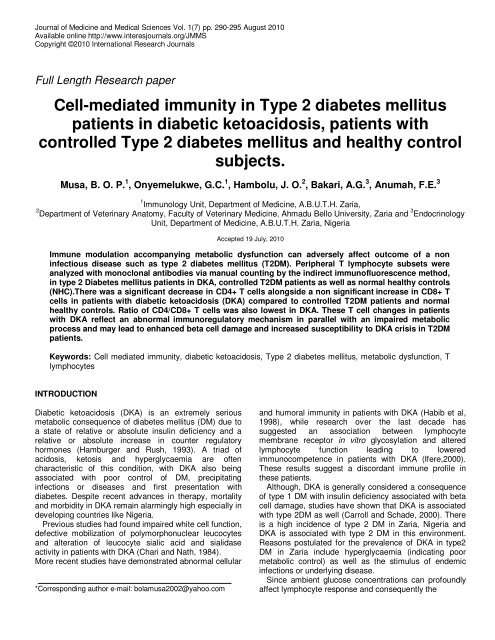
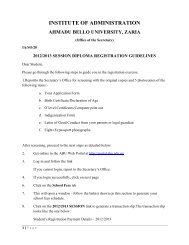
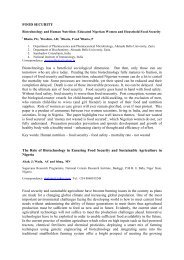

![Full Paper [PDF]](https://img.yumpu.com/49740055/1/184x260/full-paper-pdf.jpg?quality=85)

